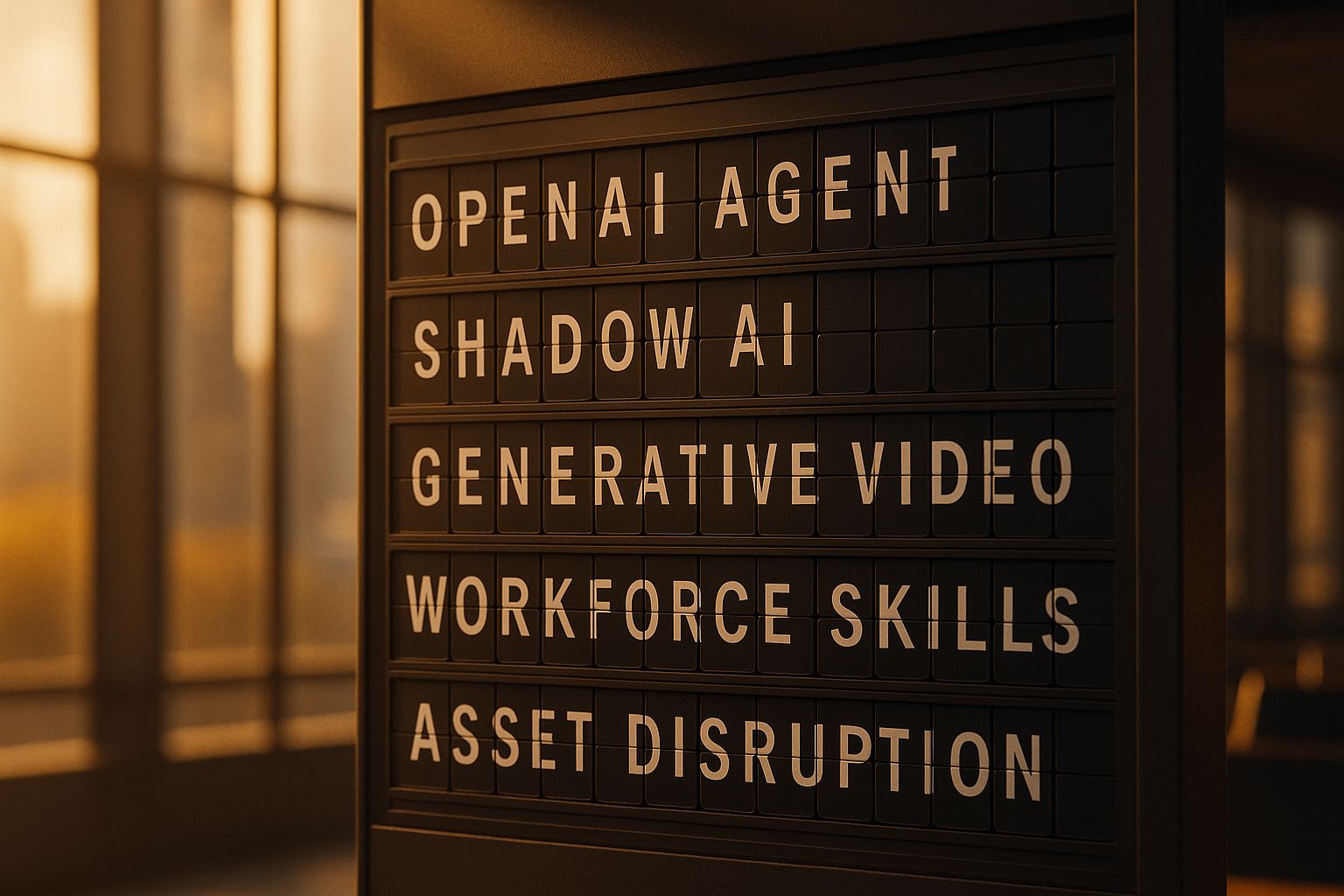Velocity Meter 7.21
Weekly news and intelligence on how AI is reshaping business. Curated by the partners at Velocity Road.

⚡ The Integration Advantage: When AI Systems Start Thinking as One
The piecemeal approach to AI is hitting a wall. While competitors are still debating which individual AI tools to deploy, the smartest companies have shifted to a fundamentally different strategy: building AI systems that think and work as integrated units rather than isolated applications.
This isn't about having more AI—it's about having smarter AI architecture. The breakthrough organizations are creating what experts call "intelligence environments" where multiple AI agents share context, coordinate decisions, and amplify each other's capabilities in real-time. Gartner predicts 70% of organizations will use AI integration platforms by 2028, up from less than 5% today.
The gap between companies with connected AI systems and those with scattered AI tools is widening rapidly—and it's becoming the defining competitive advantage of the next business cycle.
Let's dive in.

🔗 From AI Tools to AI Systems: The Integration Imperative

The age of standalone AI solutions is rapidly closing. What we're witnessing instead is the emergence of what PwC's Chief AI Officer Dan Priest calls "agentic AI"—systems that don't just respond to commands but autonomously perceive, decide, and act within defined parameters to achieve complex business goals.
Consider employee onboarding. Instead of juggling a dozen different systems with multiple human touchpoints over several days, IBM has already demonstrated how integrated AI agents can handle the entire workflow automatically: payroll entry, health insurance setup, email and video conferencing configuration, training delivery, building access provisioning, and equipment shipping—all triggered by a single request to a conversational interface.
The technology enabling this integration represents a fundamental shift in how we approach AI deployment. Rather than implementing individual point solutions, leading organizations are building what MIT's Michael Schrage and David Kiron call "intelligence environments"—enterprise systems where humans and machines don't just make decisions but also learn, reason, adapt, and continuously improve how knowledge flows through the organization.
The integration advantage is already quantifiable:
Speed: Lloyds Banking Group's Athena AI reduced information search time from 59 seconds to 20 seconds—a 66% improvement across 21,000 employees
Scale: Norway's sovereign wealth fund replaced the equivalent of 213,000 work hours using Claude AI to monitor 9,000 companies automatically
Precision: AIG compressed business review timelines by 5x while improving data accuracy from 75% to over 90%
But here's what makes integration different from simple automation: these systems don't just execute predefined workflows. They adapt in real-time, learning from each interaction and optimizing processes continuously. When OpenAI's new ChatGPT agent can seamlessly transition from analyzing your calendar to researching competitors to creating a slide deck—all within a single conversation—we're seeing the emergence of AI that truly functions as an integrated strategic partner.
📌 Bottom Line: The competitive advantage isn't in having the best individual AI tools. It's in integrating them into intelligent systems that can handle complex, multi-step workflows autonomously while maintaining human oversight and strategic direction.

🏦 AI Across Industries: Intelligence Taking the Wheel

💰 Financial Services: The New Wall Street Intelligence Layer
The financial industry is experiencing what might be the most dramatic technological transformation in its history. Anthropic's Claude Financial Analysis Solution is now performing tasks that traditionally required armies of junior analysts—parsing earnings calls, running Monte Carlo simulations, and producing investment memos with 83% accuracy on complex Excel modeling challenges. Bridgewater Associates has been using Claude since 2023 for what they call their "Investment Analyst Assistant," generating Python code and creating data visualizations with the precision of entry-level employees. Meanwhile, smaller wealth management firms like Farther are using AI tools like LevelFields to outpace industry giants, with robo-advisor assets expected to double and 78% of clients preferring tech-enabled advisors.
📌 Takeaway: Financial institutions that integrate AI across the full workflow—from research to client communication—will capture the dual benefit of reduced costs and enhanced personalization that mid-market firms can't match with traditional models.
🛡️ Insurance: From Claims Processing to Predictive Intelligence
Insurance is uniquely positioned for AI transformation because the industry's core functions—risk assessment, pattern recognition, and empathetic customer service—align perfectly with AI's emerging capabilities. McKinsey's analysis reveals that generative AI can transform everything from underwriting accuracy to claims management speed. The technology's ability to process unstructured data while adding hyperpersonalization and empathy to responses means insurers can finally deliver the seamless, human-like experience customers now expect. Companies that embrace comprehensive AI integration—rather than piecemeal point solutions—will be able to conduct more business, faster, with better risk understanding.
📌 Takeaway: Insurers face an "integrate or become obsolete" moment—customers will quickly migrate to providers offering AI-powered accuracy, speed, and personalization across the entire service experience.
📺 Marketing & Advertising: Generative Creativity Meets Strategic Precision
The advertising landscape is shifting toward AI-generated content at unprecedented speed. IAB research shows that 30% of digital video ads now use generative AI, with smaller brands leading adoption—expecting 45% AI-generated content by 2026 compared to just 36% for large brands. The technology isn't just creating content; it's enabling mass customization, with 42% of marketers using AI to create different versions of the same video for different audiences. Connected TV is experiencing parallel transformation, with programmatic buying jumping to 85% of purchases as platforms become more sophisticated and accessible.
📌 Takeaway: Agile marketing teams that combine AI content generation with strategic human insight will capture the creative scaling advantages that larger, slower-moving organizations struggle to achieve.
🏢 Workplace Evolution: The Human-AI Collaboration Framework
The future workforce is being redefined not by AI replacement but by AI augmentation at unprecedented scales. World Economic Forum research covering 1,000+ companies reveals analytical thinking (69%) and adaptability (67%) now top employer priorities, while traditional academic skills like reading and writing rank much lower (21%). Simultaneously, 20% of US workers are using AI tools without formal employer policies, with daily users saving 14 hours weekly and generating $5,038 in monthly value. This underground adoption suggests the workforce is already evolving faster than organizational AI strategies.
📌 Takeaway: Companies that proactively design human-AI collaboration frameworks—rather than letting workers figure it out themselves—will capture both productivity gains and talent retention advantages in an increasingly competitive market.

📊 AI by the Numbers: Measuring the Orchestration Economy

🚀 70% - Percentage of organizations Gartner predicts will use AI integration platforms by 2028, up from less than 5% in 2024, representing the fastest enterprise technology adoption curve in modern business history
💰 $14.8 billion - Meta's investment in Scale AI, exemplifying how companies are using massive M&A to accelerate AI capabilities, with 7 of the top 15 US M&A deals now AI-related despite overall deal volume declining 18%
⚡ 66% - Time reduction achieved by Lloyds Banking Group's Athena AI, cutting information search from 59 to 20 seconds across 21,000 employees, projected to generate £50 million in productivity improvements
🎯 40% - Potential cost base impact from AI in asset management, according to McKinsey analysis, though most firms currently allocate only 5-10% of tech budgets to transformational initiatives
📈 83% - Accuracy rate achieved by Anthropic's Claude on complex Excel modeling challenges, matching human junior analyst performance while processing tasks in minutes rather than hours

📰 5 AI Headlines You Need to Know

OpenAI unveiled its most autonomous AI system yet, capable of handling complex workflows from start to finish using its own virtual computer. The agent seamlessly integrates web browsing, data analysis, and content creation, achieving state-of-the-art performance on multiple benchmarks including 41.6% on Humanity's Last Exam. This represents a significant leap toward truly agentic AI that can manage multi-step business processes independently.
A comprehensive study reveals 20% of US professionals are using AI tools without employer permission, with 77% reporting increased work confidence and 75% believing it helps them compete with larger firms. Daily users save an average of 14 hours weekly and generate $5,038 in monthly operational value, suggesting significant untapped productivity potential in enterprise AI adoption.
McKinsey research covering 70% of global assets under management reveals the industry's technology spending paradox: increased investment hasn't translated to productivity gains because 60-80% of budgets maintain legacy systems. AI could impact 25-40% of cost bases, but success requires comprehensive workflow transformation rather than point solution deployment.
World Economic Forum analysis of 1,000+ companies shows employers now prioritize analytical thinking (69%) and adaptability (67%) over traditional technical capabilities, with programming skills ranking just 17%. This shift reflects the growing need for workers who can collaborate effectively with AI systems rather than simply operate them.
Interactive Advertising Bureau data shows 30% of digital video ads now incorporate generative AI, expected to reach 39% by 2026. Smaller brands are leading adoption with 45% AI-generated content planned versus 36% for large enterprises, demonstrating how AI is democratizing sophisticated creative capabilities previously available only to well-resourced organizations.

🎯 The Integration Advantage

This week's intelligence reveals a fundamental shift in how successful organizations approach AI. The winners aren't those with the most sophisticated individual tools—they're the ones integrating multiple AI capabilities into seamless workflows that amplify human decision-making.
Whether it's Lloyds Banking Group saving thousands of hours through intelligent information retrieval, Norway's sovereign fund automating company monitoring at unprecedented scale, or smaller wealth management firms outmaneuvering industry giants through AI-powered personalization, the pattern is clear: integration beats isolation.
The businesses that master this integration approach—designing intelligence environments where human expertise and artificial agents collaborate dynamically—will define the competitive landscape for the next decade. Those still focused on deploying individual AI tools risk finding themselves operating in isolation while their competitors build interconnected systems.
The integration moment is here. It's time to connect the dots.
📩 Ready to accelerate your AI transformation?
At Velocity Road, we help mid-market companies navigate the performance paradox by building AI adoption programs that inspire rather than intimidate. From strategic planning to workforce enablement, we ensure your AI transformation drives genuine business value.
📧 Enjoying the Velocity Meter? Subscribe here here and share with colleagues who need to stay ahead of the AI transformation.
What'd you think of today's newsletter?Vote below to let us know how we're doing. |